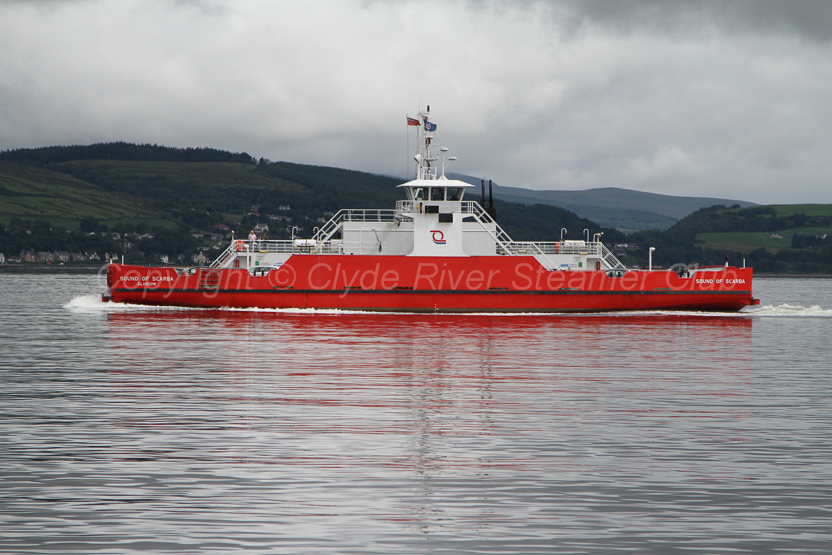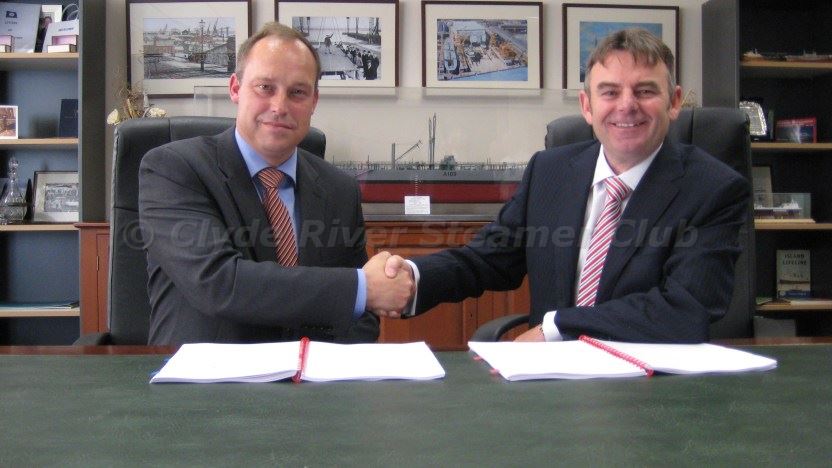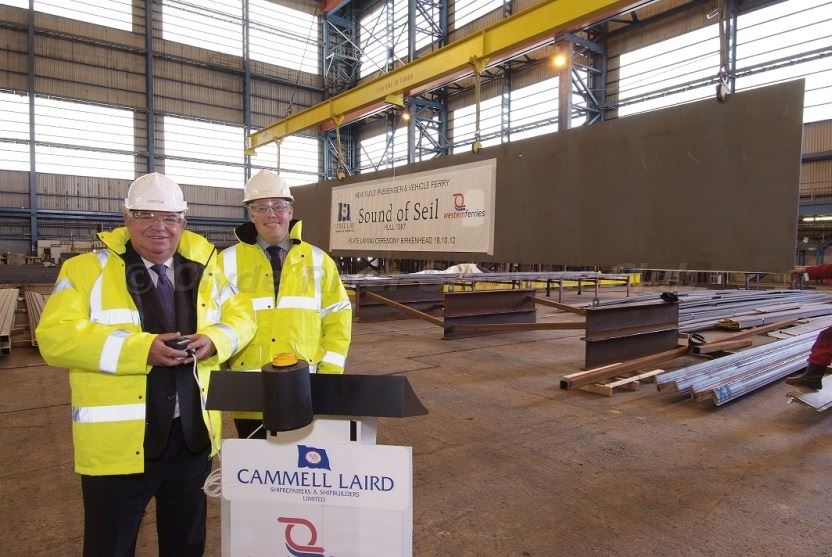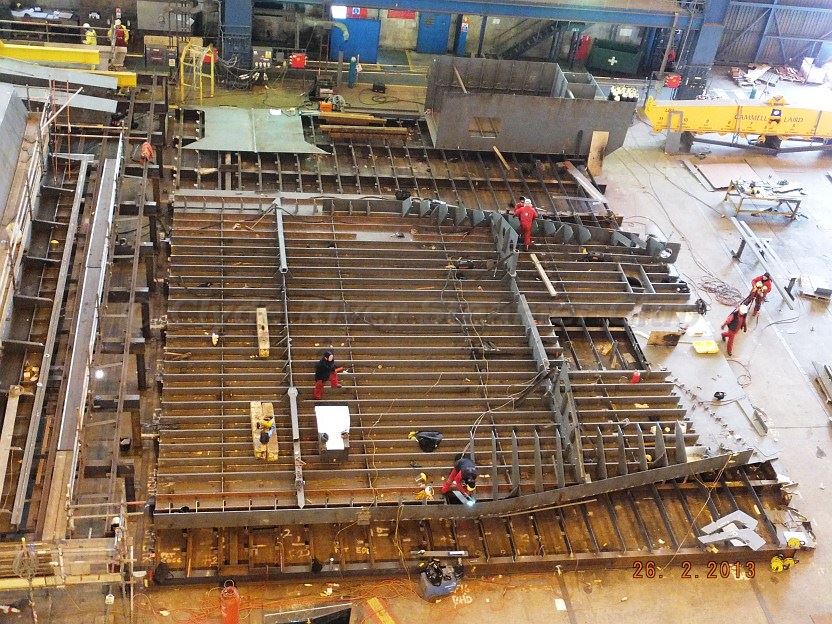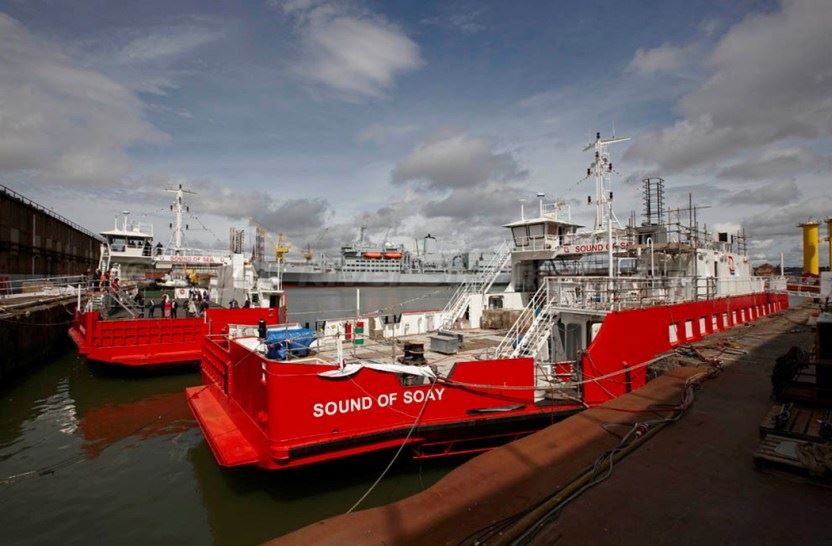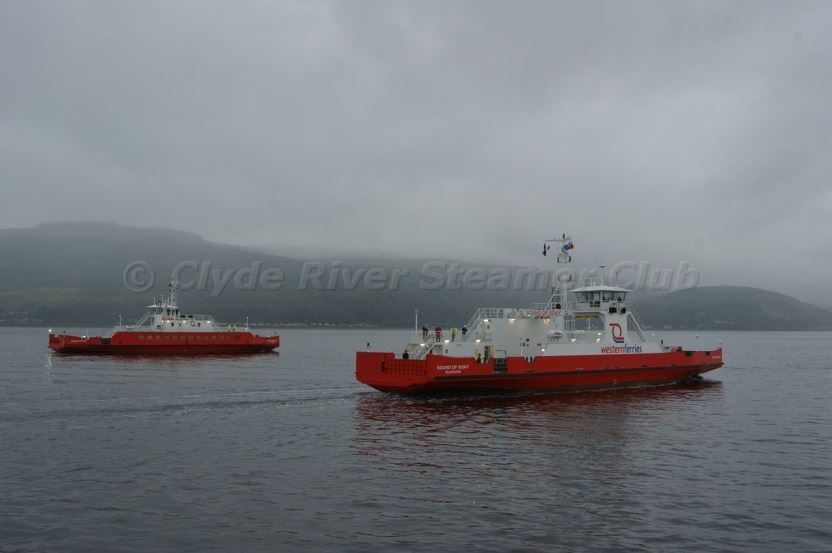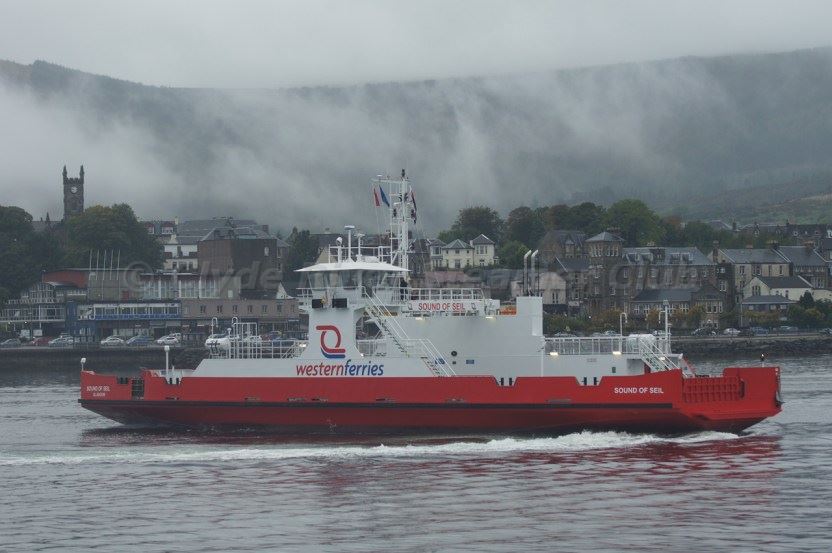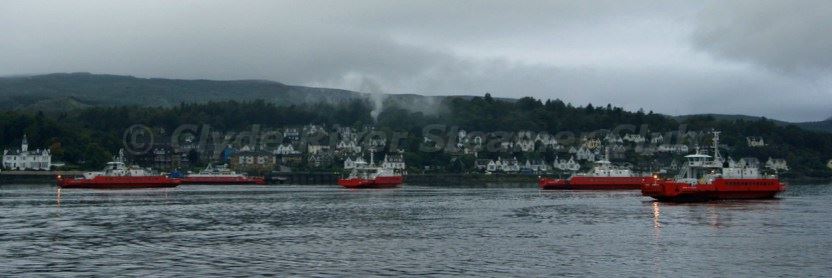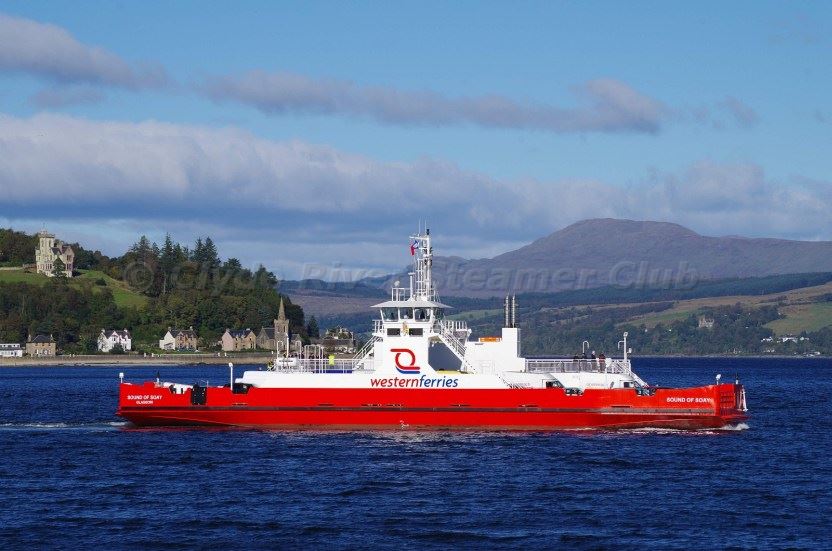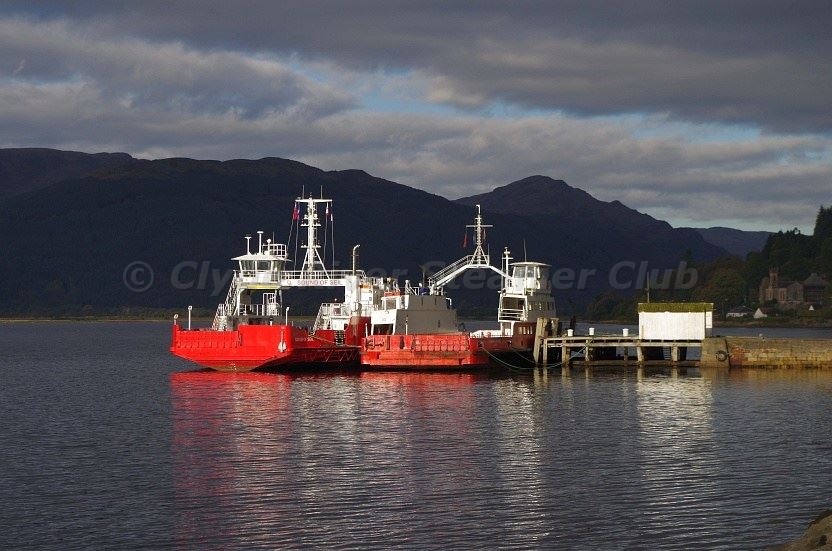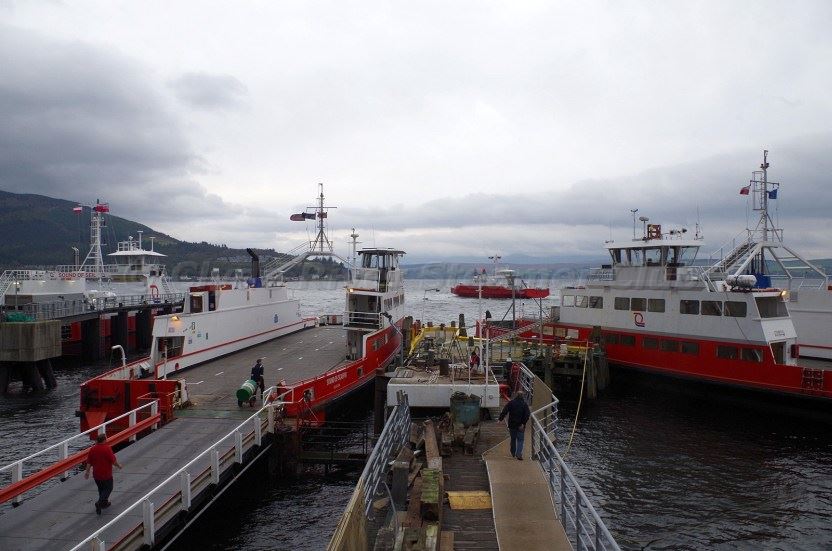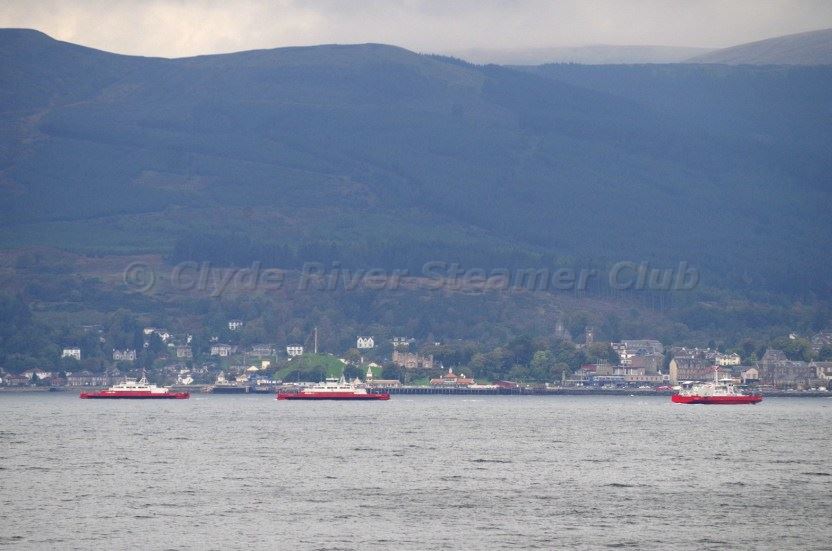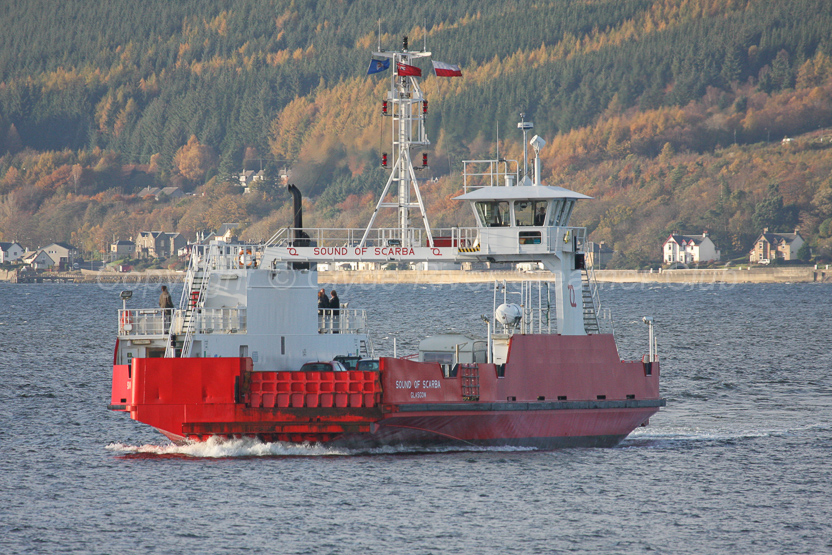The arrival of two identical sister-ships on the Clyde on Friday 4th October 2013 marked the complete transformation of the Western Ferries fleet. In eleven years the company had gone from operating a varied fleet of second hand tonnage to having a custom-built fleet of four ships, all of a similar design.
The first of them, SOUND OF SCARBA, had been built at Port Glasgow by Ferguson Shipbuilders Ltd and entered service in August 2001. She was followed by a second vessel, named SOUND OF SHUNA and also built by Ferguson’s, two years later in 2003. For the next decade this pair ran with two former Dutch ferries which, because of growing demands on the service, were gradually becoming too small and slow to cater for the rising traffic levels on the Hunter’s Quay – McInroy’s Point crossing.
With the issues surrounding the Gourock – Dunoon service finally settled – as far as the carriage of vehicles was concerned – in 2011, Western Ferries took the decision to order two new ships, updated versions of the successful Ferguson design.
Tenders were invited from several yards in Europe, with the successful bidder being announced in June 2012 as Cammell Laird Shipbuilders Ltd on the River Mersey. Despite the yard not having built any complete ships for several years, they still had a reputation for high quality refit work both for the commercial and naval sectors.
After detailed design work and approval from the regulatory authorities had been completed, the first steel was cut in the late autumn of 2012, with a plate-laying ceremony being held in November. Both vessels were built simultaneously, under cover, in the huge building hall at Birkenhead. The major hull sections – three of them, compared with fourteen sections in each of the Ferguson-built ships – were constructed upside down and then inverted for assembly into the two hulls. Whilst under cover the two ships were fully painted, too.
 |
 |
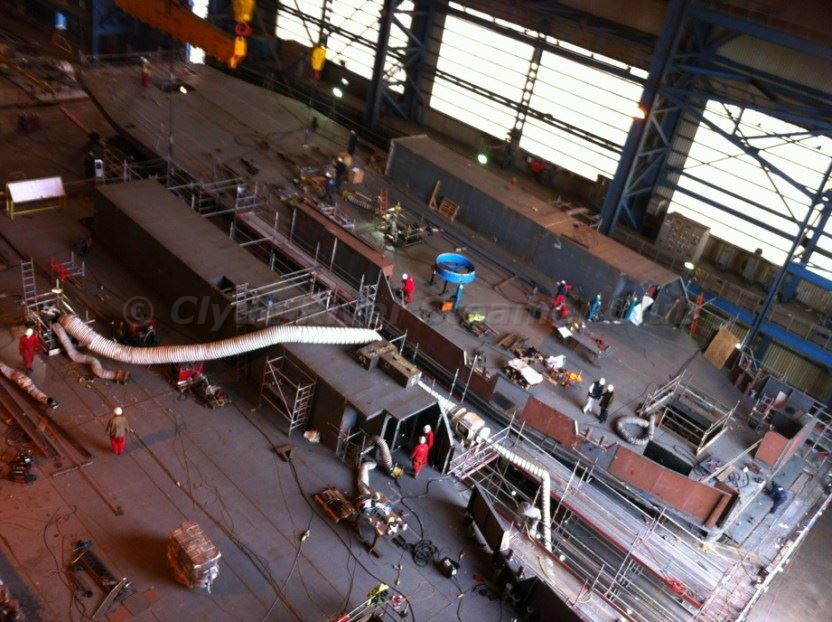 |
| The two machinery spaces were built upside down |
Inverting one of the end modules
|
Construction progresses in the huge building hall |
The two hulls take shape
On Monday 22nd July the first ship was moved out of the building hall and taken down to the water’s edge. Left sitting on a special cradle, her ‘launch’ was a simple, inelegant affair – she simply floated free of the cradle as the tide rose that morning. Once afloat, SOUND OF SOAY was towed into the yard’s Tranmere Basin to complete fitting out.
The second vessel followed suit on Thursday 25th July and bore the name SOUND OF SEIL. Although they had been launched in reverse order – SOUND OF SEIL was Yard No. 1387 while her sister was Yard No. 1388 – fitting out aboard SOUND OF SEIL was more advanced at the time of her launch. With internal outfitting work proceeding more rapidly on board the ‘SEIL’, the painters had moved further ahead on her sister, hence her being put into the water first.
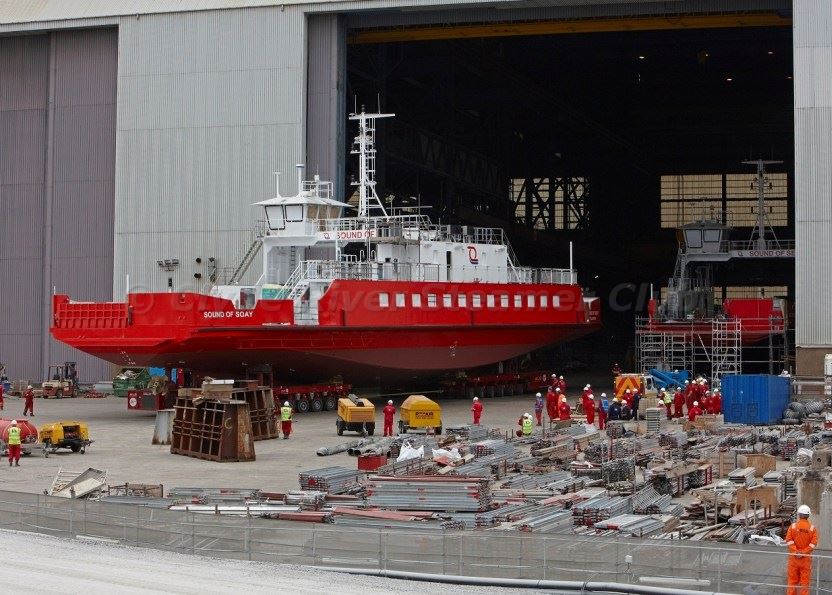 |
 |
 |
| Fully painted, SOUND OF SOAY leaves the building hall |
SOUND OF SEIL makes her way down to the water’s edge |
In place and waiting for the tide to rise
|
Having been launched with no ceremony, the pair were officially named on Thursday 15th August, SOUND OF SEIL by Mrs Glenis Coles, whose husband is a master with the company, and SOUND OF SOAY by Mrs Maria Chittick, whose husband is a long-standing member of the company’s office staff ashore at Hunter’s Quay.
Both ships formally named and nearing completion
SOUND OF SEIL was first to run trials, leaving the Tranmere Basin on Thursday 4th September, while the ‘SOAY’ ran trials on Saturday 21st September.
With final fitting out complete, and suitable weather forecast for the next few days, the pair sailed from Birkenhead at 1030 on Thursday 3rd October, SOUND OF SOAY leading the way. Heavy rain turned to dense fog as they passed the Isle of Man, the two ships remaining close as they made their way north. Progress was good, and speed was reduced to allow them to arrive on the Clyde for a pre-arranged rendezvous with CLYDE CLIPPER, which had been chartered to convey invited guests, the press, and off duty staff to meet the new arrivals as they sailed up the Clyde.
Making their way up the Firth of Clyde
John Crae
Passing inshore of the Gantocks, SOUNDs OF SOAY and SEIL slowed as they approached Dunoon Pier, before demonstrating their manoeuvrability by pirouetting in unison off the pier. Making their way along the Cowal coastline, they then headed for an impromptu meeting with their two elder siblings, SOUND OF SHUNA was just leaving Hunter’s Quay while SOUND OF SCARBA was making her way over from McInroy’s Point. SOUND OF SCALPAY, lying at Hunter’s Quay pier and about to be displaced by one of the new arrivals, looked on disdainfully.
SOUND OF SEIL pirouettes off Dunoon
John Crae
Standing off until other vessels had come and gone, SOUND OF SEIL then made a tentative approach to the old linkspan at Hunter’s Quay, and lowered her ramp. As expected, it was a perfect fit, and she then moved to the new linkspan for a similar trial. She was soon joined at the linkspans – between the other vessels maintaining the service in their usual business-like manner – by her sibling. Following this both new vessels crossed to McInroy’s Point and carried out trials there, too.
Arriving at Hunter’s Quay
John Crae
From McInroy’s Point the pair headed to the James Watt Dock, where they berthed for the weekend. On Monday 7th, SOUND OF SEIL left the dock and carried out trials which culminated in her being issued with her Passenger Certificate, this task being looked after by the local Glasgow MCA Office. Two days later she moved to Kilmun, where she remained for the next few days.
Meanwhile, SOUND OF SOAY had been granted her Passenger Certificate on Tuesday 8th and following crew familiarisation, she entered service at 1500 on Wednesday 9th. Ironically, perhaps, on her maiden voyage she carried a small McGill’s bus that was on hire to Argyll Ferries Ltd, and which was being used on a ‘Ferry Replacement Service’ while linkspan repairs were being carried out at Gourock, and the passenger-only ferry service was reduced to an hourly timetable.
SOUND OF SOAY on her maiden voyage
The entry into service of SOUND OF SOAY meant the end for SOUND OF SANDA, and she moved to Greenock to lay up for a few days. SOUND OF SCALPAY continued to run until the weekend, before joining SOUND OF SEIL at Kilmun after making her last crossing on the Saturday afternoon. She was back at Hunter’s Quay on the Monday, though, where spare gear was landed. When she went back to Kilmun she tied up alongside her new sister, and then canted her before making fast to the pier herself.
SOUND OF SEIL waits to enter service at Kilmun
On Tuesday 15th SOUND OF SEIL moved to Hunter’s Quay and, with little fuss, duly entered service that afternoon. The next day the two ex-Dutch vessels returned to Hunter’s Quay. Having been sold to The Underwater Centre at Fort William, they were handed over to their new owners at 1400 and set off immediately for their new careers on Loch Linnhe.
The two new builds are practically identical in dimensions to the twins built by Ferguson’s, but have much improved passenger accommodation. One, the ‘SOAY’, is fitted with red seating in the saloon, the other with blue, but that apart are to all intents and purposes identical. Toilet accommodation has been rethought, resulting in a better layout within the same space constraints.
The machinery is similar to that fitted to the earlier vessels, but with a more up-to-date version of the Cummins main engines. The area that has been changed most is the bridge. Instead of a central console with steering positions forward and aft, there is now a split console with more ergonomic controls fitted for the helmsman to operate.
Western Ferries now runs four ferries of equal capacity – each can carry around 40 cars and a maximum of 220 passengers – which are fully interchangeable. With few differences between all four ships crews are, by and large, able to step aboard any member of the fleet and feel immediately at home, thanks to a large degree of commonality between the sisters.
The arrival of the two Mersey-built ships concluded a multi-million pound programme that now sees the company running – for the first time – a fleet of four new purpose-built ferries on the short crossing between Cowal and Inverclyde.
Article and photographs, unless shown otherwise, from John Newth
Western Ferries – The Fleet












